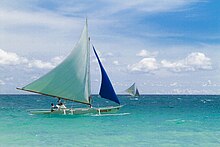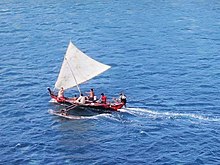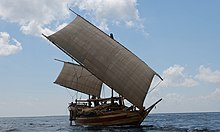Pinas (ship)
 British postage stamp depicting a Malay pinas, 1955
|
The pinas, sometimes called "pinis" as well, is one of two types of junk rigged schooners of the east coast of the Malay peninsula, built in the Terengganu area. This kind of vessel was built of Chengal wood by the Malays since the 19th century and roamed the South China Sea and adjacent oceans as one of the two types of traditional sailing vessels the late Malay maritime culture has developed: The bedar and the pinas.
Description

The pinas is a sailing vessel built exclusively in the kuala (Malay: rivermouth)[1] of the Terengganu river. It was the largest of the ships built in the area, and was only used for deep sea navigation to distant ports. The pinas carried two masts, one in the bow, called "Topan", slightly raked forward, and the main mast, called "Agung" placed a bit forward of the center of the boat. The pinas had a very long bowsprit, slightly bent downwards by the bobstay.

Both masts carried a fully battened lug or "Junk"-sail of typical Chinese design. These sails were not made of cloth but of a matting material called "tikal" that is also used for floor matting and other purposes. Like most junk sails the battens were made of bamboo, usually creating 6 individual panels to the sail. The haliard was attached almost in the middle of the yard, and since the luff of the sail was nearly straight and only about half the length of the markedly convex leach, the yard, when hoisted, was sitting in an angle of about 15° – 20° with the vertical.
The foresail was set on the port side of the Topan and the mainsail on the starboard side of the Agung. A relatively small jib was set on the very long bowsprit. All pinas, even the big ones of 80 feet and above were steered by a tiller with a pulley block system easing the strain on a conventional rudder hinged on the stern post. This tiller was operated from within a round cabin (cup) placed on the stern of the boat. This cabin was housing the accommodation of the crew as well. The hold was reserved for the cargo.
These boats sailed best with the wind on the quarter or just aft of the beam. Since the sails are fully battened and may be set almost at a right angle to the boat, they were able to set the Topan sail to windward, sailing wing to wing as soon as the wind was well aft of the beam. Going to windward was not the strong point of those junk rigged vessels, since the junk rig performs not as efficiently to windward as the modern Bermuda sail or the Gaff sail and the hulls of the cargo freighters were well rounded and offered not much lateral resistance.

The clipper type bow of the pinas often carried a carved figurehead called "Gobel" and the transom stern was raked aft and reached pretty high up above the waterline. The pinas had a well defined sheer and was a seaworthy vessel.
The hull of the pinas is influenced by European boats of the early nineteenth century or later, and might well be a copy of the East Indiamen of the middle of the 19th century. The locals say that a Frenchman whose boat was wrecked on the shore of Terengganu in the 19th century settled there and his knowledge is said to have influenced the boatbuilding of the shipwrights.
The word pinas, locally pronounced almost sounds like penis, is obviously derived from the French word pinasse, which describes a small, usually two-masted sailing vessel. The English word pinnace, a man-of-war's tender, is a deduction from the French word.
These boats are also called Perahu (Malay: boat)[2] pinas Golok, to distinguish them from other types built with a straight stem and without a beak (figurehead) the pinas Dogar. Golok, (Malay: cleaver/machete)[3] or sword with a convex cutting edge, refers to the curved, clipper like bow.[4]
These picturesque boats had been plying the South China Sea for centuries hauling cargo or being used in the pirate trade and the last few were still used as sailing freighters in the 1980s.
Building technique

The pinas boats of Terengganu are built using the indigenous technique the Malays have developed to build wooden boats. They build without plans, hull first, frames later. The planks are fire bent and joined edge on edge (carvel) using "basok" (wooden dowels) made from Penaga-ironwood (Mesua ferrea). There is no European style caulking hammered into a groove between the planks: Before the new plank is hammered home, a strip of kulit gelam (Malay: paperbarks skin)[5] of the Melaleuca species is placed over the dowels. This 1 – 2 mm layer of a natural material has remarkable sealing properties.[4] It is an ancient and unique building technique, the origins of which might date back to the Proto-Malay migrations that colonised the archipelago thousands of years ago.
History
The tradition of building wooden boats in modern Malaysia reaches far back in time: For overseas trade, for fishing, for piracy, for travelling up the many rivers, for each purpose they developed a special design.[6]
With Malacca becoming the main trading centre for the spices arriving from the Molucca islands (Indonesia) the Malay Peninsula turned into a melting pot of the seafaring, trading civilisations: Indians and Chinese, Arabs and Indonesians, Vietnamese and Thai, Burmese, Europeans and others, they all arrived in their distinctive craft, inspiring the Malay shipbuilding.[6]
The two “Perahu Besar”, (Malay: big boat).[7] of Terengganu, the pinas and the bedar are the result of this cultural interchange. Jib and bowsprit of the two are of western origin, with junks almost never carrying one.[4]
The desire for the ever-faster and more manoeuvrable vessel combined the positive elements and created these junk hybrids.
The boatbuilders of Terengganu were re-“discovered” during the World War II by the Japanese navy who had wooden minesweepers built there by the carpenters and fishing folks.[6]
Since that time the Malays have stopped building sailing boats for their own use, but they kept manufacturing fishtrawlers and ferries, built using the old techniques. Rising timber prices and lack of demand forced one after the other yard out of business, so today this tradition is on the brink of extinction, with very few able craftsmen still practicing this rare old building technique.
After the 2nd world war was over, the boat building of the island of Duyong in Kuala Terengganu was again discovered by traditional boat enthusiasts from western countries. Amongst those boats that were built, there were 8 pinas including one big enough to qualify as a "Perahu Besar", the pinas Naga Pelangi.
The pinas built for westerners are:
| Name of boat | Builders (shipyard) | LOD | Year built | Original owner | Country |
|---|---|---|---|---|---|
| Jun Bathera, now June Bathra | Abdullah bin Muda | 52 ft (16 m) | 1976 | Christine, Rohani Longuet | France |
| Sri Duyong | Abdullah bin Muda | 52 ft (16 m) | 1976 | William Harburn | Australia |
| boat was never named | Che Ali bin Ngah | 45 ft (14 m) | 1982 – project abandoned | Claude Besnar | France |
| Bilbo – bedar/pinis mix | Che Ali bin Ngah | 60 ft (18 m) | 1985 | Francis Clement | Belgium/Italy |
| June Bathra 2 | Abdullah bin Muda | 52 ft (16 m) | 1976, launched 1986 | Larry Smooky | USA |
| Haji Rashid (Seberang Takir) | 60 ft (18 m) | 1986, launched 2003 | Olivier | Switzerland | |
| Yok Yor | assembled craftsmen of Duyong | 60 ft (18 m) | 1997 | Philippe Poggi | France |
| Naga Pelangi | Hasni bin Ali | 72 ft (22 m) | 2004, launched 2009 | Christoph Swoboda | Germany |
Gallery
-
The pinas Naga Pelangi sailing butterfly
-
The pinas Naga Pelangi 2010 in Langkawi
-
The pinas Naga Pelangi beating at 7 knots
-
The Jun Bathera, a pinas built in 1976, sailing in the estuary of the Terengganu river, 1981
-
The pinas Sri Duyong in Singapore, 1980
-
The pinas Jun Bathera on Duyong island, 1979
-
An old pinas model floating on the Terengganu river, 1981
-
Building a pinas 2004 - plank bending 1
-
Building a pinas 2004 - plank bending 2
-
Building a pinas 2004 - fitting the first plank, the garboard strake
-
Building a pinas 2004 - producing the wooden dowels
-
Building a pinas 2004 - applying the caulking bark
-
Building a pinas 2004 - no frames yet
-
Building a pinas 2004 - frames are adjusted to hull
-
Building a pinas 2004 - all frames and stringers are in place
See also
- Bedar (ship)
- Junk rig
- Junk (ship)
- Keying (ship)
- List of schooners
- Lorcha (boat)
- Pinisi, Indonesian sailing rig
- Palari, Indonesian ship using pinisi rig
- Tongkang
References
- ^ https://translate.google.com/#ms/en/kuala
- ^ https://translate.google.com/#ms/en/perahu
- ^ https://translate.google.com/#ms/en/golok
- ^ a b c Cargo Boats of the East Coast of Malaya, Gibson-Hill, C.A. (1949), JMBRAS 22(3), p. 106-125
- ^ https://translate.google.com/translate_t?&text=kulit%20gelam
- ^ a b c Keeping the Tradition of Boatbuilding Alive, Keith Ingram, Magazine: Professional Skipper March/April 2007, p. 70
- ^ https://translate.google.com/translate_t?&text=Perahu%20Besar
- ^ Boats, Boatbuilding and Fishing in Malaysia, The Malaysian Branch of the Royal Asiatic Society,, MBRAS 2009, p. 349/350




















